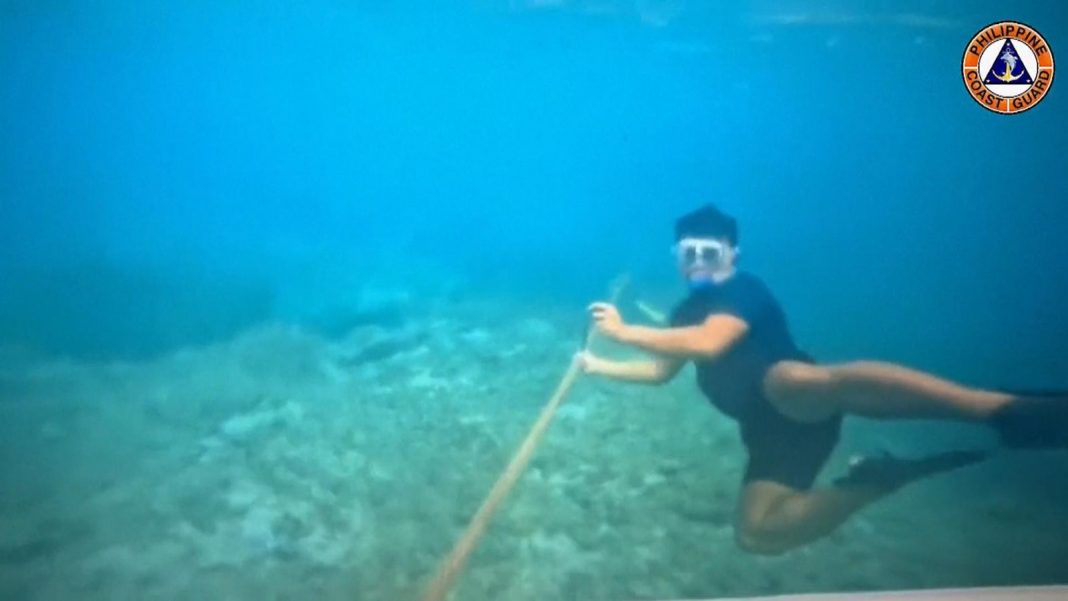Tensions are growing between the Philippines and China as a dispute over a fiercely-contested fishing area in the South China Sea escalated on Tuesday.
The Philippines has said it will not back down as Beijing attempts to block its fishermen from the shoal, with Beijing warning not to “cause trouble”.
But in an act described as a “special operation” by Manila, the Philippines on Monday cut a 300m (980ft) floating barrier installed by the Chinese.
The Scarborough Shoal, the fishing spot about 200km (124 miles) off the Philippines coast and within its exclusive economic zone (EEZ), has been a disputed sites for decades.
China calls the area Huangyan Island – which is about 850km (528 miles) off the mainland – and says the Philippines is “intruding” into its waters.
Read more: The Philippines accuses China’s coast guard of firing water cannon at its vessel
Philippine Coastguard spokesperson Commodore Jay Tarriela told CNN Philippines: “They might still return the floating barrier once again, they might still do shadowing and dangerous manoeuvres once again.”
“We have shown the world the Filipino people will not back down,” he added, insisting the nation is going to “consistently carry out whatever is necessary” to keep its presence.
Earlier, he claimed four Chinese vessels were in the area when a Philippine ship approached and were “not that aggressive”. He said it was clear there were members of the media were on board the ship.
China’s coastguard had even removed parts of the barrier, he said.
Tensions are high – and so are the stakes
The South China Sea has been a contentious place for years, but this incident is just the latest in a series that show how these decades old disagreements are heating up.
China’s development and militarisation of various islands and reefs within the sea it claims as its own has been ongoing for a long time.
But in just the last year there have been incidents of Chinese ships using military grade lasers and water cannon against Philippines vessels and there have been pictures taken by the press of huge Chinese coast guard ships stalking tiny Philippines fishing boats.
The establishment of barriers such as the one targeted in this video is also, according to local fishermen, a relatively regular occurrence.
While Chinese behaviour may be becoming more assertive, there is, it seems, a shift in the Philippines’ response too.
This incident is the first time such a barrier has actually been removed (and on the orders of the president no less) and the marked increase in pictures of the incidents appear to be because the Coast Guard is more readily inviting journalists along to take a look.
Indeed, although China seized the Scarborough Shoal (where this incident took place) in 2012 it had been allowing Philippines fishermen to operate nearby, that is until relations soured under the new president Ferdinand Marcos Jr who took office last year.
There is, it feels, a hardening of lines on both sides, although both are painfully aware of how high the stakes are if tensions and standoff ever spilled over into more.
Beijing, meanwhile, “firmly upholds the sovereignty and maritime rights of Huangyan Island”, foreign ministry spokesperson Wang Wenbin said.
Relations between the two states have soured over the past year, as new president Ferdinand Marcos Jr – who authorised the barrier’s cutting – looks to build ties with the US.
The president’s moves towards the West have seen the US military given expanded access to Philippine bases – much to Beijing’s anger.
The Permanent Court of Arbitration at the Hague ruled in 2016 there was no basis under international law for China’s claim to most of the South China Sea, a ruling not recognised by Beijing.
Nonetheless, control of the shoal is a sensitive issue for China, which has maintained a constant presence of coastguard ships and fishing vessels there for the past decade.
Manila even claims Beijing’s coastguard has committed aggressive acts, like using a military-grade laser to deter resupply missions to troops stationed on a grounded warship.







